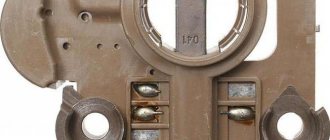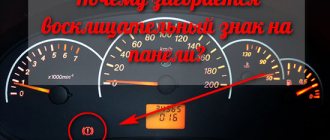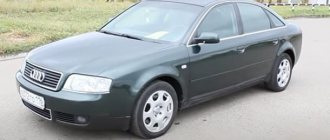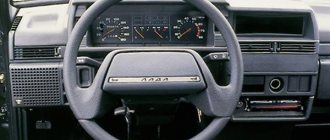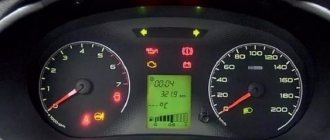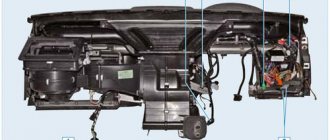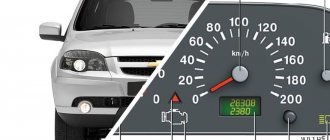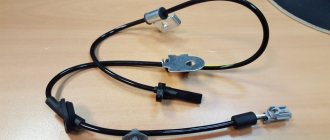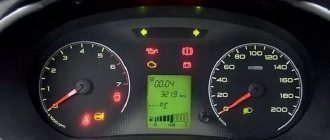A modern car is equipped with a large number of auxiliary electronic systems that increase driving safety. Some solutions improve directional stability, others affect braking efficiency, etc.
Drivers are familiar with these systems by their abbreviated names: ABS, ESP, EBD, etc. At the same time, one of the first systems to appear on cars was the ABS system, the main task of which was to prevent complete wheel locking during braking.
Moreover, in some countries it is prohibited by law to operate cars without ABS on public roads. Of course, if this system fails, the behavior of the car when braking changes greatly, and not for the better. The ABS icon also lights up on the dashboard, indicating that the problem needs to be repaired.
Why does the ABS and ESC light come on?
ABS malfunction may be caused by:
_x000D_
- _x000D_
- failure of wheel rotation sensors; _x000D_
- malfunction of the hydraulic valve block; _x000D_
- damage to the wiring. _x000D_
_x000D_
If the ABS malfunction indicator light comes on, you must contact a service station as soon as possible for diagnostics (read error codes) and repairs.
The most common cause of ABS failure is damage to the wiring near the ABS sensor connector. It is located under the fender liner, but is still not well protected from moisture and dirt.
location of the rear ABS sensor on the Lada XRAY wiring harness of the rear ABS sensor on the Lada XRAY
As a result, the wires oxidize and break, and the ABS lamp lights up.
damaged ABS sensor wires on a Lada XRAY damaged ABS sensor wires on a Lada XRAY
Briefly about the functioning of anti-locking
Cars equipped with ABS do not lose control during any type of braking. Anti-skid system components:
- control device;
- speed sensors for each wheel;
- hydraulic pressure control unit in the brake line.
The ABS unit on Vesta receives a signal from the rotation sensors of each wheel. Based on this data, the processor issues commands to the hydraulic unit of the brake system. Until the car comes to a complete stop, directional stability is maintained, even if the driver tries to press the pedal all the way.
ABS unit on Vesta. Photo source: https://www.drive2.ru/l/527903571115510325
The anti-lock braking system is controlled by a magnetic adjuster. Working positions of the mechanism:
- When the wheel locks, the valve stops the flow of brake fluid to the RTC.
- If rotation does not resume, then pressure is released into the outlet line.
- When rotation begins, pressure is applied to the RTC.
A magnetic device regulates the braking forces on each wheel. The valve actuation speed is up to 10 times per second. Disabling ABS does not affect the braking system, which continues to operate as normal. But without anti-lock, the stability of the car in case of emergency braking is reduced.
How to repair wiring
We remove the wheel, and then the locker (for the front wheel, turning out the fastening screws) or the protective shield (for the rear wheel, turning out the two fastening nuts “10”). Press the latch and disconnect the block with wires from the ABS sensor. We inspect the connector and make sure there is no corrosion or damage. In case of damage, we restore the integrity of the wires:
restoration of the ABS sensor wiring on the Lada XRAY restoration of the ABS sensor wiring on the Lada XRAY
We treat it with a special means for cleaning electrical contacts (for example, graphite grease) and clean the contacts from oxides. We clean the wheel speed sensor and the surface around the sensor from dirt.
Attention! Keep ABS sensors away from magnets as this may cause damage.
Replacing ABS sensors
If the cause of the malfunction is not in the wiring, but in the ABS sensor itself, we replace it. To do this, first unscrew the fastening screw with a Torx T30 key, and then remove the sensor wiring harness from the bracket. The photo shows a Lada Vesta car; on other Lada models the work is performed in a similar way.
Instructions for replacing the front wheel ABS sensor:
Instructions for replacing the front wheel ABS sensor Instructions for replacing the front wheel ABS sensor
Instructions for replacing the rear wheel ABS sensor:
Instructions for replacing the rear wheel ABS sensor Instructions for replacing the rear wheel ABS sensor
Is it possible to disconnect without consequences?
When thinking about how to disable ABS on a Grant, it is important to remember: “arbitrariness” will lead to some questions during maintenance, which will be visible to the on-board computer technicians. When contacting service during the warranty period, the fact that ABS is turned off is the reason for refusal of free repair.
How to carry out the procedure correctly?
- First, open the mounting block where the fuses are located. It is located near the battery. Sometimes you have to remove the 15-amp fuse, but the car's instructions will help clarify this issue.
- Then the ignition is turned on briefly, and it is important that the brake system and ABS lights do not go out. After the sound signal, the ignition must be turned off.
- Then comes the removal of the block with the bottom cover. The electrical wire from the fuse is cut lengthwise and its ends are stripped to about 2 cm.
The problem of how to disable ABS can be easily solved: you will need a five-pin relay, which can be purchased at any auto store. A thorough study of the contact pattern will help carry out the procedure without negative results.
Work begins with winding contacts 86 and 85. It is necessary to connect the wire going to ground to them. The second wiring is responsible for supplying the signal. The contact marked “30” should connect to the wire coming from the fuse, while 88 should connect to the ABS. The shutdown button can be placed anywhere in the cabin.
How does Vesta behave on ice using ABS and ESP?
We decided to test the Lada Vesta in the winter - it’s interesting how the operation of the above systems will behave. For testing, we chose an ice testing ground with a length of 700 m. It was important for us to find out in which cases the system would perform poorly and in which cases it would perform well. For greater stability, we equipped the sample we tested with Nokian tires.
Typically, such tests begin by turning off both systems. This is not surprising - after all, it is important for us to know how a “naked” car behaves on ice. To disable ABS+ESP, you will need to remove the voltage supply - namely, remove the fuse responsible for their operation. If you don’t pull it out, then no matter how much you poke your finger at the ESP switch off button, the on-board electronics will in any case force it to turn on at speeds over 50 km/h.
So, let's start, since good studded tires help us get off the ice. We see a turn, we try to fit into it, but at the same time we feel that the car is starting to skid. The front wheels confidently hold traction, but the rear is unstable - however, nothing critical.
An experienced driver will overcome such a small skid without any particular difficulties by pressing down on the accelerator pedal - fortunately, the test site allows this. The fact that the car drives very confidently even on icy surfaces is definitely encouraging - at the same time, the quality of control does not suffer, Vesta clearly responds to the slightest rotation of the steering wheel, turns smoothly, and does not fidget while moving in an arc.
We stop and turn on the anti-lock and directional stability systems. We start it up and hit the road again - and the car practically does not suffer from loss of dynamics.
Once again, excellent wheels come to the rescue. In this case, ESP + ABS do not respond instantly to changing driving conditions.
Most likely, problems will begin only when the car completely skids. If you get into a real side drift, the electronics are unlikely to help you out. In such a situation, the driver may not be able to save the situation, because the fuel supply control will already be controlled by the on-board electronics - no matter how much you press the gas, you will not get an adequate response from the car.
Summarizing the above, we can safely say that with the exchange rate stability and anti-lock systems turned off, Vesta showed a highway completion time 8 seconds faster than when ABS and ESP were turned on. As one can easily assume, this result is due to the fact that the turned on systems in some way suppressed the driver’s actions, wasting precious time assessing the responses of various sensors. However, during an ordinary trip on an icy road, the systems, on the contrary, will only help while driving, preventing loss of course and skidding.
How to drive - with or without ASB+ESP, it's up to you to decide. Only your driving style and your driving experience influence this decision.
Downloading a book
After successfully completing the payment (by any method) and returning to the KrutilVertel store from the payment system website, you will be taken to the successful payment page:
The book you purchased will be in your personal account, from where you can always download it.
Please note that after making the payment, you need to return back from the payment system website to the KrutilVertel website. If for some reason you did not return back to the site and closed the payment system tab with a message about the successful completion of the payment, please let us know - we will send you a letter indicating access to download the book
If for some reason you did not return back to the site and closed the payment system tab with a message about the successful completion of the payment, please let us know - we will send you a letter indicating access to download the book.
Cuvette test Lada Vesta with and without ESP
The winter road promises many hidden dangers. Often the right side of the roadside looks like a snow-covered, flat surface. However, a very large number of motorists who, for one reason or another, have to drive onto it, annoyedly (and, alas, belatedly) end up in a real ditch, covered with a seemingly horizontal layer of snow.
Our new test of the Lada Vesta is designed to find out what advantages the ESP system provides, specifically designed to control the distribution of vehicle forces in difficult situations. For greater clarity, we decided to drive into a ditch and try to get out of it, first without the exchange rate stabilization system, and then using it.
Let's say right away that the car had to work hard. Almost in a dangling state, its two wheels balanced on the edges of the ditch - in this case, as a rule, it is almost impossible to do without outside help. But we dare to assure you that the factory electronics did not let us down. The on-board “brains” accurately dosed the injection of gasoline, allowing not only to let the car stand up straight, but also to climb onto the opposite side of the ditch, returning to the roadway.
Let us remind you that we performed all the above maneuvers with the ESP system engaged.
Next we disabled ESP. In this case, no attempts or tricks to move the car from an awkward position were successful. The wheels of the front axle only bit into the snow and ice harder and harder. In such a situation, leaving the ditch is possible only with great luck or with outside help.
The test results revealed a clear benefit provided by the ESP system on the Lada Vesta. This applies to both smooth road surfaces and roads with poor traffic. In general, the presence of an electronic stability control system will be an excellent help for both beginners and experienced drivers - after all, when they want to help you, is it worth refusing?
Lada Vesta test video:
How does Vesta behave on ice using ABS and ESP?:
Cuvette test Lada Vesta with and without ESP:
Lada Vesta hill climb test:
Currently, all LADA models ( Lada XRAY , Vesta, Largus, Granta, Kalina, Priora, Niva 4×4) without exception are equipped with ABS (anti-lock braking system).
During the operation of the car, many owners notice that the ABS and ESC lamps (if this system is available) light up on the instrument panel. Let's figure out how to solve this problem and improve the design.
We advise you to read our articles
“Bringing to life” the control unit
Failure to operate the unit is a consequence of contact burnout, which is caused by increased voltage. The second reason that there is no contact is mechanical or chemical influence. With a thoughtful approach, repairing the ABS unit is simple. Having conveniently positioned the part on the workbench, you need to carefully open the body using a construction knife. You shouldn’t run it too deep, otherwise you can damage the electrical wires.
Having identified the break point, using a pulse soldering iron, the damaged wires are resoldered. You can use a Weller soldering station. It is not recommended to overheat the ceramic base to avoid damaging the board. A damaged board will require replacement. After this, all that remains is to assemble the block and install it back.
The problem is not always the block. Sometimes you have to change the sensors located on the rims. If you want to restore the functionality of the old device yourself, without resorting to installing a new one, it becomes necessary to rewind the coil built inside the sensor. The work of restoring the system is thankless, so it is recommended to contact service centers. This will save a lot of effort, nerves and money.
For those who don’t know what kind of animals these are: ABS and ESP.
The ABS system is an anti-lock braking system that can prevent wheel spin during braking maneuvers - this is necessary to ensure greater driving safety.
The ESP system is a solution to ensure directional stability, designed to prevent the car from skidding (the necessary wheels are braked, this is controlled by an electronic unit). By the way, ESP itself without ABS is absolutely useless, because it is, let’s say, an add-on to it.
WHY IS THE ABS AND ESC LIGHT ON LADA?
ABS malfunction may be caused by:
- failure of wheel rotation sensors;
- malfunction of the hydraulic valve block;
- damage to the wiring.
If the ABS malfunction indicator light comes on, you must contact a service station as soon as possible for diagnostics (read error codes) and repairs.
The most common cause of ABS failure is damage to the wiring near the ABS sensor connector. It is located under the fender liner, but is still not well protected from moisture and dirt.
As a result, the wires oxidize and break, and the ABS lamp lights up.
Decoding Vesta errors related to the data bus (U)
- 0001 – pin failure at the physical level;
- 0002 – block wiring is damaged;
- 0009 – short circuit of lines touching the on-board circuit or body;
- 0073 – diagnostic output disabled;
- 0121 – there is no signal from the ABS unit;
- 0122 – ESP controller does not respond to the request;
- 0155 – open circuit of the control panel;
- 0167 – the immobilizer does not respond to the diagnostic scanner request;
- 0415 – standard error of ABS Vesta;
- 0416 – similar for the ESP system;
- 0426 – the immobilizer transmits incorrect information to the on-board computer system.
HOW TO REPAIR LADA WIRING
We remove the wheel, and then the locker (for the front wheel, turning out the fastening screws) or the protective shield (for the rear wheel, turning out the two fastening nuts “10”). Press the latch and disconnect the block with wires from the ABS sensor. We inspect the connector and make sure there is no corrosion or damage. In case of damage, we restore the integrity of the wires:
We treat it with a special means for cleaning electrical contacts (for example, graphite grease) and clean the contacts from oxides. We clean the wheel speed sensor and the surface around the sensor from dirt.
Attention! Keep ABS sensors away from magnets as this may cause damage.
Articles about Lada X Ray Cross
Is it risky to continue driving if the ABS system is faulty?
People think differently, but if you think about it, there is nothing terrible here. After all, if ABS turns off, simple brakes will work as they should. The only thing that can be annoying is the ABS error indicator constantly burning in front of your eyes.
How to eliminate an ABS error yourself
Typically, an error can appear if the sensor itself is dirty. To fix the problem you need to clean it. But first you need to find out which wheel the sensor broke down on. This is found out by using a scanner on the car. You can do this yourself using a mobile phone together with an error scanner.
Having found out which of the 4 sensors is broken, you need to remove the wheel and find out where the sensor is connected. Then you need to dismantle it and clean it from contamination. Most likely he got stuck. This is usually why the malfunction error message comes on.
You shouldn’t immediately go and order new sensors; you need to start with smaller ones and find out the reason. If there is no money or opportunity to repair the vehicle, then there is no need to be upset, because before we drove without ABS and everything was fine.
28.04.2019
REPLACEMENT OF LADA ABS SENSORS
If the cause of the malfunction is not in the wiring, but in the ABS sensor itself, we replace it. To do this, first unscrew the fastening screw with a Torx T30 key, and then remove the sensor wiring harness from the bracket. The photo shows a Lada Vesta car; on other Lada models the work is performed in a similar way.
Instructions for replacing the front wheel ABS sensor:
Instructions for replacing the rear wheel ABS sensor:
Let's sum it up
As you can see, the ABS system is not particularly complex in terms of design, but it performs important functions and directly affects safety. For this reason, it is recommended to carry out preventive diagnostics of ABS, as well as eliminate any failures and malfunctions of the system if the slightest sign of trouble occurs.
We also recommend reading the article about why the brake pedal fails after replacing the brake pads and what can cause such malfunctions. From this article you will learn why the brake pedal fails or becomes soft after replacing the brake pads, as well as what the driver should do.
In any case, if the ABS light is on, it should be taken into account that the anti-lock braking system is disabled and sudden braking will lead to wheel locking. For this reason, it is important to avoid situations where emergency braking is required, and to detect and correct the malfunction as quickly as possible by actively applying the methods described above.
Why do the brakes on your car squeak, you can hear the brakes grinding, whistling or squeaking when braking: the main reasons. Brake pads squeak, what should the driver do?
The brake pedal is too tight, does not press down or has become soft, the brakes fail: main faults, diagnostics and troubleshooting methods.
How to brake correctly in a car with a manual transmission: types of standard braking on a manual transmission, emergency and emergency braking, tips.
The brake pedal is soft after replacing the brake pads: why are the brakes weak, is it necessary to bleed the brake system. What nuances should you pay attention to?
The brake pedal falls to the floor, the brakes disappear unexpectedly, after replacing the brake fluid, pads, brake discs: the main causes of the malfunction.
What is an automatic transmission brake band: the purpose of the element and its features. Signs that your brake band needs adjustment and how to adjust it.
Standard fault codes for the Lada Largus in the regular or cross version can be read independently or with the help of appropriate specialists. On-board equipment is easy to maintain and repair.
Depending on the diagnostic method, the problem may be displayed on the instrument display or on the diagnostic scanner screen. The encryption of information is also different.
HOW TO IMPROVE THE LADA DESIGN
To protect the wiring harness from the environment, you can use a D-shaped seal. We lay the wires in it and wrap it with electrical tape. We put everything in the corrugation. We glue the cover covering the ABS sensor connector around the perimeter with the same sealant. This will prevent moisture and dirt from entering the area where the sensor and connector are located.
Attention! If the ABS fails, the brakes remain operational, but the braking efficiency is reduced, which is especially dangerous on some surfaces.
Fuse integrity
So, the first thing you need to pay attention to when problems arise is the integrity of the fuses.
After a visual inspection of the fuse insert, you can forget about existing problems.
The main thing is to inspect the connections and connectors for damage and oxidation.
Very often, even minor damage to contacts and abrasions lead to a malfunction of the entire system.
If a blown fuse is identified, it must be replaced.
